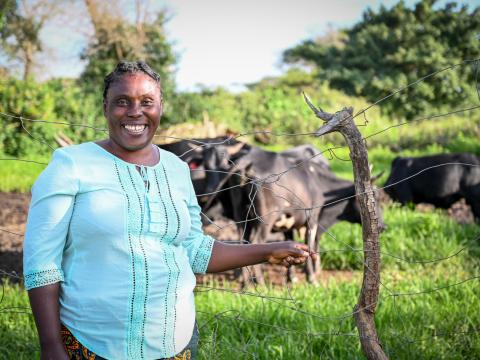
Gender equality today for a sustainable tomorrow
Abigail and Sarah write for International Women's Day about five ways they have discovered that women’s empowerment boosts child well-being
Every year on International Women’s Day, World Vision celebrates the way women and girls are working to make the world a better place and to #BreakTheBias.
We know that globally, women and girls face discrimination and inequality worldwide. Women hold only 25.6% of national government positions; and 1 in 3 women have experienced physical or sexual violence in their lifetimes.
We know that women’s empowerment drives better development outcomes. When women are empowered, children flourish. This is broadly understood at World Vision and throughout the development sector.

But last year, we recognised a need to better understand why women’s empowerment is so vital to the well-being of children. We know our programming supports gender equality. But we couldn’t comprehensively articulate the links between women’s empowerment and World Vision's child well-being targets like ensuring children experience good health or are educated for life.
To identify these links, we conducted a literature review: Equality and empowerment: Critical pathways to child well-being. This review brings many important associations between women’s and girls’ empowerment and child well-being into one report, providing a comprehensive overview.
It is overwhelmingly clear that when women can access resources and opportunities, participate in systems of power and make decisions that impact their lives, they experience personal well-being. This profoundly improves child well-being by almost every measure. Here are five important ways women’s empowerment influences child well-being.

Women’s level of education has a direct bearing on their children’s health and education outcomes.
Women with higher educational attainment are more likely to vaccinate their children, breastfeed their children, and seek treatment for child illnesses. Children of educated women attend school for longer. Their daughters are more likely to be enrolled in school. Educated women also experience better economic outcomes, delayed marriage, and increased contraceptive use.
When women have increased economic opportunities, this can positively influence norms about girls’ status and education opportunities.
Women’s increased economic opportunities can influence how families and communities value girls, which can increase the support families give towards girls’ education. Women’s increased economic opportunities can further influence social norms related to women’s economic engagement.
Women’s agency is linked to child health.
Research indicated women who could freely make decisions within their households and over crop production had greater influence on how much to allocate to household food as well as regarding how the food was allocated within the household. In some contexts, their agency over food production and allocation has been found to have significant and positive effect on children’s weight and height for age.

Women’s experience of intimate partner violence affects child well-being.
Another important finding was how intimate partner violence affects child well-being. The literature review found intimate partner violence (IPV) and violence against children co-occur in a significant proportion of households. Children in households affected by intimate partner violence are also much more likely than other children to experience violent forms of punishment. And children can experience short and long-term impacts from witnessing IPV, even when they are not physically or sexually harmed themselves. For example, girls and boys who witness intimate partner violence are more likely to experience greater sleep disturbances, anxiety and depression, insomnia and self-harm and aggressive behaviours. These findings highlight the need to use a comprehensive approach to addressing violence – working to address family violence as an integrated issue.
Finally, girls and boys begin to markedly experience the impact of gender inequality in adolescence.
The experiences, expectations and disparities they face often mirror those of the adults in their lives. Adolescent girls (ages 15-19) have been found to experience higher rates of intimate partner violence than other groups of women.
The review showed us that we need to address disparities across girls’ life cycles. Otherwise, the benefits of our programming with girls may not be sustained into their adulthood, and we must start over with the next generation of girls. Addressing the barriers girls and their families face when it comes to getting girls to school – distance, gender norms, menstrual hygiene, child marriage – makes for educated, empowered women who will raise healthier children.
Secondly, the research made clear what many of us knew implicitly – that World Vision’s work to increase child well-being is not implemented in a vacuum. This research has highlighted the importance of system’s approaches to child and adolescent well-being. As a child-focused organisation, we must address systems of inequality and disempowerment that exist around and among boys and girls and women and men in families, communities and societies. This is the only way to reach our aim of sustained child well-being.
To read Equality and empowerment: Critical pathways to child well-being click here
To learn more about World Vision's work across a range of sectors click here
Abigail Howe-Will, is World Vision International's Gender Equality and Social Inclusion Technical Director and Sarah Shteir is World Vision Australia's Senior Gender Equality Advisor.

